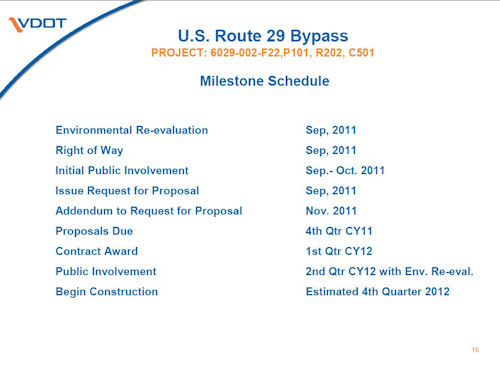Albemarle Supervisors declined to ask state highway officials to update an 18-year-old analysis of the Charlottesville Bypass before putting the project out for bids. It’s full speed ahead for the controversial, $245 million project.
By James A. Bacon
The Albemarle County Board of Supervisors nixed a resolution Wednesday to ask the state highway department to update a traffic and environmental analysis of the Charlottesville Bypass before putting the $245 million project out for bids. The board voted instead to ask the Virginia Department of Transportation to complete the update before construction commences.
Why the controversy? Ann H. Mallek, the board chair, and Dennis S. Rooker argued that it is crucial to get updated information in circulation before VDOT issues the Request for Proposal. That way, contractors will know exactly what they are bidding on and the state won’t have to come back later with expensive change orders.
But a majority of board members were satisfied that the project schedule laid out by VDOT at a previous board meeting would accommodate any needed changes. They worried that putting off bids until the completion of the Environmental Impact Statement would create unnecessary delays for a project that has languished for nearly 20 years.
In remarks after the board meeting, Mallek conceded that the compromise resolution “has no power.” VDOT is not obligated to honor the board’s request. Further, once a contract is awarded, it will be too late to request changes to the project design without incurring extra charges. Morgan Butler, senior attorney with the Southern Environmental Law Center, termed the final resolution “meaningless.” Even Neil Williamson, president of the Free Enterprise Forum, described it as a “toothless resolution.”
The original Environmental Impact Statement (EIS) for the U.S. 29 Bypass was written 18 years ago, and a supplemental impact statement, focused mainly on protecting the county’s drinking-water reservoir, was completed eight years ago. Although the project has received all necessary approvals, VDOT is required to conduct a written re-evaluation before construction begins. Mallek and Rooker contended that the data in the old evaluations are seriously out of date and that new data could influence the final design. Not only are the traffic numbers obsolete, but recent scientific research has documented the detrimental effects of highway pollutants on the health of children – a particularly sensitive issue given that six schools are located near the proposed Bypass route.
The resolution called on VDOT to update traffic modeling of the bypass, consider the scientific research on the effects of highway pollutants, conduct an analysis of health and noise impacts, engage with citizens in a public hearing, and consider a reduction in the bypass design speed from 60 miles per hour to 50 miles per hour.
Supervisor Kenneth Boyd contended that it was not necessary to hold up the RFP, which VDOT has scheduled for September. “They’ve told us they’re going to award a design-build contract with the caveat that they’ll come back after the public hearing and may make change orders.”
Under VDOT's ambitious timetable the EIS update is scheduled to begin this month and the RFPs to be issued. "Initial public involvement" will take place in September-October. VDOT expects to award a contract in the first quarter of 2012, then hold another round of public involvement in the second quarter of 2012. Construction is estimated to begin in the fourth quarter of the year.

(Click on graphic for larger image.)
As a concrete instance of what worries her, Mallek said during the board meeting that VDOT, to her knowledge, has not yet given any thought to installing sound walls to protect the neighborhoods and schools impacted by the six-mile, four-lane highway. Identifying the need for sound walls – an expense that could run into the millions of dollars – would best take place before the RFP so any contractor would know to include the cost in his bid.
While the VDOT process does allow for change orders – a process that has worked successfully in other locations – Rooker argued that such additions would cost less when incorporated into a competitive bidding process than into a change order negotiated with a contractor that already had the business.
While Mallek tried to play conciliator, Rooker took other supervisors to task for their inconsistency. Addressing Lindsay Dorrier Jr., he said, "Every little thing that impacts Scottsville, you're all over. If the Scottsville Community Center loses $10, you're all over it." How could Dorrier deny the citizens of Rooker's district the opportunity to get more information in a timely manner about how a four-lane highway project would impact them?
In a four-two vote the board rejected the original Mallek-Rooker proposal, then in another four-two vote, denied a revised version that would have required the EIS update to be complete before the contract was awarded. The final version, requiring the EIS update only before construction began, was approved unanimously.
“The original resolution was designed to get the state to get the most critical information on the table before bidding out the contract,” said Butler, the SELC attorney. The resolution approved by the board, he said, “allows the project to move forward at breakneck speed without adequate information.”
Williamson, the business advocate, was pleased by the final outcome. “This document (the resolution) was created by individuals with the desire to delay the bypass. The idea of gathering information before the RFP clearly would have delayed the bypass for a number of months.”
=============
This article was reported and written thanks to a sponsorship by the Piedmont Environmental Council.

